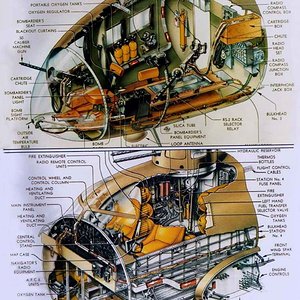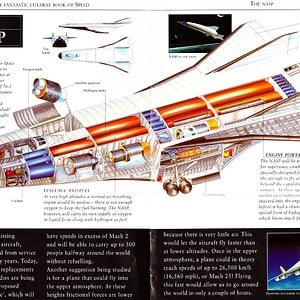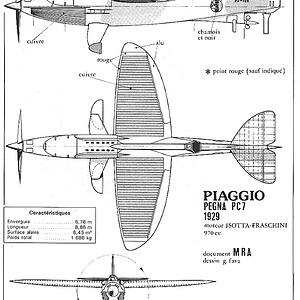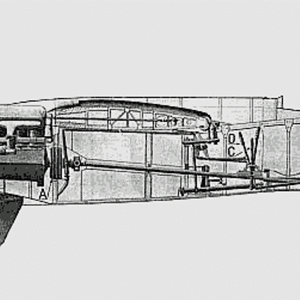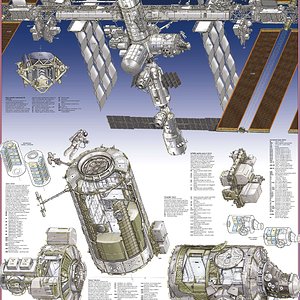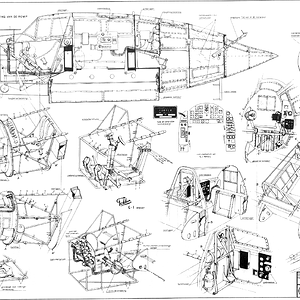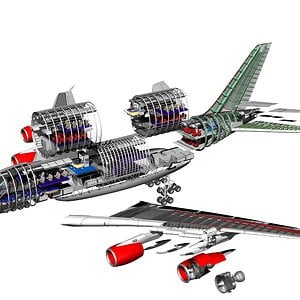Navigation
Install the app
How to install the app on iOS
Follow along with the video below to see how to install our site as a web app on your home screen.
Note: This feature may not be available in some browsers.
More options
You are using an out of date browser. It may not display this or other websites correctly.
You should upgrade or use an alternative browser.
You should upgrade or use an alternative browser.
Design and development
Seeking to avoid the aerodynamic drag induced by floats in seaplanes of floatplane design, Ing Giovanni Pegna of the Piaggio company designed a very unusual seaplane to represent Italy in the 1929 Schneider Trophy race. A cantilever shoulder-wing monoplane known both as the Piaggio P.7 and the Piaggio-Pegna P.c.7, his design floated up to its wings on its long, slender, watertight fuselage with the wings resting on the water, and employed twin high-incidence hydroplanes to get itself off the water during take-off runs.[1]
Sources differ on the P.7's engine; it is described both as an Isotta-Fraschini Special V6 rated at 723 kilowatts (980 horsepower)[citation needed] and as an Isotta-Fraschini AS-5 rated at 745 kilowatts (1,000 horsepower).[2] The engine was connected both to a two-bladed, automatic variable-pitch tractor propeller by a long metal shaft and by another shaft to a smaller marine propeller, similar to those used on motorboats, mounted beneath the aircraft's tail. To take off, the pilot would start the engine with the flight propeller feathered and the normal carburettor air intake closed and use a clutch to engage the tail propeller and get the aircraft moving through the water. The two hydroplanes, mounted beneath the fuselage on struts connected to the fuselage just forward of the wings similar to the way in which floats were mounted on floatplanes, would cause the P.7 to rise out of the water almost immediately. After the aircraft had risen on its hydroplanes and the flight propeller had cleared the water, the pilot would open the carburettor air intake, again employ the clutch to disengage the marine propeller, and use another clutch to engage the flight propeller, which automatically would switch from feathered to flight pitch. Driven by its flight propeller, the aircraft then would engage in a conventional take-off, riding on its submerged hydroplanes until it reached take-off speed.[1]
Without the aerodynamic drag induced by floats or the weight they added to an aircraft, Pegna projected that the P.7 would reach high speeds. Sources differ on the speeds he predicted, claiming both 580 km/h (360 mph)[citation needed] and 700 km/h (434.7 mph).[3]
[edit]Testing
Piaggio manufactured one P.7 and turned it over to the Italian Schneider Trophy racing team. Although some pilots refused to fly the aircraft, the Italian Schneider team's Tommaso Dal Molin conducted some water tests on Lake Garda in northern Italy. The spray the hydroplanes generated made it difficult to see during take-off, and persistent problems with both clutches ensued. The aircraft never became airborne.[1]
Not ready in time, the P.7 was excluded from the 1929 Schneider Trophy race, in which a Macchi M.52R and two Macchi M.67 seaplanes represented Italy. Piaggio and Pegna abandoned plans to build a second P.7.[1]
[edit]Operators
Italy
[edit]Specifications
Data from Italian Civil and Military aircraft 1930-1945.[1][4]
General characteristics
Crew: 1
Length: 8.8583 m (29 ft 0.75 in)
Wingspan: 6.76 m (22 ft 2 in)
Height: 2.451 m (8 ft 0.5 in)
Wing area: 9.83 m2 (105.8 sq ft)
Empty weight: 1,403 kg (3,093 lb)
Gross weight: 1,682 kg (3,709 lb)
Powerplant: 1 × Isotta-Fraschini V-12 liquid-cooled piston engine, 630 kW (850 hp)
Sources differ, claiming both that the P.7's engine was an Isotta-Fraschini Special V6 rated at 723 kW (970 hp)[citation needed] and an Isotta-Fraschini AS-5 rated at 745 kW (999 hp)[1] Performance
Maximum speed: 600 km/h; 324 kn (373 mph)
Sources differ on the P.7's projected maximum speed, claiming both 580 km/h (360 mph)[citation needed] and 700 km/h (434.7 mph).
Seeking to avoid the aerodynamic drag induced by floats in seaplanes of floatplane design, Ing Giovanni Pegna of the Piaggio company designed a very unusual seaplane to represent Italy in the 1929 Schneider Trophy race. A cantilever shoulder-wing monoplane known both as the Piaggio P.7 and the Piaggio-Pegna P.c.7, his design floated up to its wings on its long, slender, watertight fuselage with the wings resting on the water, and employed twin high-incidence hydroplanes to get itself off the water during take-off runs.[1]
Sources differ on the P.7's engine; it is described both as an Isotta-Fraschini Special V6 rated at 723 kilowatts (980 horsepower)[citation needed] and as an Isotta-Fraschini AS-5 rated at 745 kilowatts (1,000 horsepower).[2] The engine was connected both to a two-bladed, automatic variable-pitch tractor propeller by a long metal shaft and by another shaft to a smaller marine propeller, similar to those used on motorboats, mounted beneath the aircraft's tail. To take off, the pilot would start the engine with the flight propeller feathered and the normal carburettor air intake closed and use a clutch to engage the tail propeller and get the aircraft moving through the water. The two hydroplanes, mounted beneath the fuselage on struts connected to the fuselage just forward of the wings similar to the way in which floats were mounted on floatplanes, would cause the P.7 to rise out of the water almost immediately. After the aircraft had risen on its hydroplanes and the flight propeller had cleared the water, the pilot would open the carburettor air intake, again employ the clutch to disengage the marine propeller, and use another clutch to engage the flight propeller, which automatically would switch from feathered to flight pitch. Driven by its flight propeller, the aircraft then would engage in a conventional take-off, riding on its submerged hydroplanes until it reached take-off speed.[1]
Without the aerodynamic drag induced by floats or the weight they added to an aircraft, Pegna projected that the P.7 would reach high speeds. Sources differ on the speeds he predicted, claiming both 580 km/h (360 mph)[citation needed] and 700 km/h (434.7 mph).[3]
[edit]Testing
Piaggio manufactured one P.7 and turned it over to the Italian Schneider Trophy racing team. Although some pilots refused to fly the aircraft, the Italian Schneider team's Tommaso Dal Molin conducted some water tests on Lake Garda in northern Italy. The spray the hydroplanes generated made it difficult to see during take-off, and persistent problems with both clutches ensued. The aircraft never became airborne.[1]
Not ready in time, the P.7 was excluded from the 1929 Schneider Trophy race, in which a Macchi M.52R and two Macchi M.67 seaplanes represented Italy. Piaggio and Pegna abandoned plans to build a second P.7.[1]
[edit]Operators
Italy
[edit]Specifications
Data from Italian Civil and Military aircraft 1930-1945.[1][4]
General characteristics
Crew: 1
Length: 8.8583 m (29 ft 0.75 in)
Wingspan: 6.76 m (22 ft 2 in)
Height: 2.451 m (8 ft 0.5 in)
Wing area: 9.83 m2 (105.8 sq ft)
Empty weight: 1,403 kg (3,093 lb)
Gross weight: 1,682 kg (3,709 lb)
Powerplant: 1 × Isotta-Fraschini V-12 liquid-cooled piston engine, 630 kW (850 hp)
Sources differ, claiming both that the P.7's engine was an Isotta-Fraschini Special V6 rated at 723 kW (970 hp)[citation needed] and an Isotta-Fraschini AS-5 rated at 745 kW (999 hp)[1] Performance
Maximum speed: 600 km/h; 324 kn (373 mph)
Sources differ on the P.7's projected maximum speed, claiming both 580 km/h (360 mph)[citation needed] and 700 km/h (434.7 mph).


